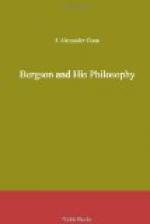the same movement. There would then be two movements,
with an interval of rest. Neither from within,
by the muscular sense, nor from without, by sight,
should we have the same perception. If we leave
our movement from A to B such as it is, we feel it
undivided, and we must declare it indivisible.
It is true that when I look at my hand, going from
A to B, traversing the interval ab, I say to
myself ’the interval ab can be divided
into as many parts as I wish, therefore the movement
from A to B can be divided into as many parts as I
like, since this movement covers this interval,’
or, again, ’At each moment of its passing, the
moving object passes over a certain point, therefore
we can distinguish in the movement as many stopping-places
as we wish—therefore the movement is infinitely
divisible.’ But let us reflect on this for
a minute. How can the movement possibly coincide
with the space which it traverses? How can the
moving coincide with the motionless? How can the
object which moves be said to ‘be’ at
any point in its path? It passes over, or, in
other words, it could ‘be’ there.
It would ‘be’ there if it stopped there,
but, if it stopped there, it is no longer the same
movement with which we are dealing. It is always
at one bound that a trajectory is traversed when,
on its course, there is no stoppage. The bound
may last a few seconds, or it may last for weeks,
months, or years, but it is unique and cannot be decomposed.
Only, when once the passage has been made, as the
path is in space, and space is infinitely divisible,
we picture to ourselves the movement itself as infinitely
divisible. We like to imagine it thus, because,
in a movement it is not the change of position which
interests us, it is the positions themselves which
the moving object has left, which it will take up,
which it might assume if it were to stop in its course.
We have need of immobility, and the more we succeed
in presenting to ourselves the movement as coinciding
with the space which it traverses, the better we think
we understand it. Really, there is no true immobility,
if we imply by that, an absence of movement."[Footnote:
Translated from La Perception du Changement, pp. 19-20.]
This immobility of which we have need for the purposes
of action and of practical life, we erect into an
absolute reality. It is of course convenient
to our sense of sight to lay hold of objects in this
way; as pioneer of the sense of touch, it prepares
our action on the external world. But, although
for all practical purposes we require the notion of
immobility as part of our mental equipment, it does
not at all help us to grasp reality. Then we
habitually regard movement as something superadded
to the motionless. This is quite legitimate in
the world of affairs; but when we bring this habit
into the world of speculation, we misconceive reality,
we create lightheartedly insoluble problems, and close
our eyes to what is most alive in the real world.
For us movement is one position, then another position,




